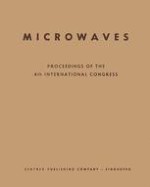1963 | OriginalPaper | Chapter
The influence of space-charge and geometry on the efficiency of a two-cavity-klystron oscillator
Author : F. Paschke
Published in: Microwaves
Publisher: Macmillan Education UK
Included in: Professional Book Archive
Activate our intelligent search to find suitable subject content or patents.
Select sections of text to find matching patents with Artificial Intelligence. powered by
Select sections of text to find additional relevant content using AI-assisted search. powered by
Since the invention of the klystron generator by Arsenjewa-Heil and Heil [l] in 1935 there appeared many papers on the theory of this device. Nonlinear analyses were limited to models with zero space-charge forces 2, 3, 5, 11 or to one-diraensional models 5, 11. In the two-dimensional klystron theories of Webber [10] and Paschke [8] feedback was not treated. In the one-dimensional model, however, the range of the space-charge force is unlimited for the electric field of an infinitely broad bunch does not decay in axial distance from the bunch. In practice, the range of the space-charge force is limited because of the finite 1 ateral dimension of beam and drift tube. At small signals there is, except for the existence of higher order modes in finite beams, only a quantitative but not a qualitative difference between the con-vection-current distributions of finite and infinitely broad beams; the reduction of the range of the space-charge force is associated with a reduction in plasma frequency. At large signals, however, there is also a qualitative difference which is evidenced by the experiments of Mihran [6], [7]. The physical reason for this difference is due to the dispersion of the space-charge waves. In a one-dimensional beam the plasma frequencies corresponding to fundamental and harmonic signal frequencies are identical. For this reason mixing can produce only mul tipies of the plasma frequency. Thus the periodicity of the convection-current distribution found at small signals is maintained up to large signal levels. In a finite beam the plasma frequencies corresponding to the harmonics differ from the plasma frequency corresponding to the fundamental signal frequency; furthermore, the ratios of these plasma frequencies are, in general, irrational numbers. At large signals the convection current therefore becomes a non-periodic function of distance.
